Archive for March 2007
A many-splendored thing 5: Sampling

Sakuran.
From DB:
 While I’ve been here, Hong Kong has been embroiled in two big stories. First is the runup to the election for chief executive. Hong Kong has indirect elections, whereby groups purportedly representing constituencies, chiefly various business interests, are in turn represented by electors. On the day of the vote, I saw several demonstrations demanding both new environmental policies and universal suffrage. So much for the myth that Hong Kong people don’t participate in politics.
While I’ve been here, Hong Kong has been embroiled in two big stories. First is the runup to the election for chief executive. Hong Kong has indirect elections, whereby groups purportedly representing constituencies, chiefly various business interests, are in turn represented by electors. On the day of the vote, I saw several demonstrations demanding both new environmental policies and universal suffrage. So much for the myth that Hong Kong people don’t participate in politics.
Current chief executive Donald Tsang Yam-kuen, Beijing’s appointee, won the election, with 649 votes out of 789 voting members. Tsang has promised to introduce direct voting and universal suffrage by 2012. We’ll see.
The other big story has been the aftermath of a 2006 shootout involving police constable Tsui Po-ko. The latter has the confusing intricacy of a Hong Kong cop movie. Some years ago Tsui allegedly killed another cop and stole his pistol; a year later he robbed a bank. (The Economist offers a summary here.) An inquest has been under way. Wednesday’s South China Morning Post (not available free online) reports on the contents of Constable Tsui’s notebooks. There are indications that he was tailing political figures and calculating how an ambush might be carried out beneath traffic underpasses.
The media have gone wild over this and even replayed the episode of the local version of Who Wants to Be a Millionaire? on which Tsui appeared as a contestant. Today’s edition of the SCMP reports an even weirder turn. An FBI expert has testified that Tsui suffered from schizotypal personality disorder. This is characterized by “social isolation, odd behavior and thinking, and often unconventional beliefs.” Sound like you or me?
Moving to the more comforting world of cinema, let me catch up on some of the films I’ve seen at Filmart and the Hong Kong International Film Festival.
Ying Liang’s The Other Half: A shrewdly constructed story about a young woman with marital troubles who becomes a legal stenographer. Ying interweaves her life crises with the monologues of locals who come to seek action from the lawyer. These incidents were derived, Ying explained in the Q & A, from actual cases the non-actors knew. Ying collected over 100 law cases and then showed his script to lawyers and legal professionals, some of whom appeared in the film. Single-take scenes predominate, making good use of the deep-focus capacities of digital video. A vivid angle into ordinary life in China, with insights as well into problems of industrial pollution.
Li Yu’s Lost in Beijing: Less interesting, I thought. A fairly traditional melodrama involving an innocent woman caught between two macho men, husband and boss, and the boss’s scheming wife. The glimpses of life in Beijing were more valuable than the supposedly scandalous sex scenes that feature heavily in the early reels.
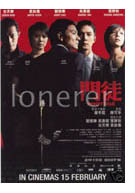 Derek Yee’s Protégé: Yee is a mid-range Hong Kong director who can turn out solid entertainment and sometimes, as with One Nite in Mongkok, some social criticism. In Protégé, you know you’re in for a rough time from the start. A smack-addled mom staggers onto a sofa to die, and her little girl waddles over to yank out the needle and drop it carefully into a wastebin. Whether you love or hate The Departed, Protégé reminds us that Hong Kong film can chop closer to the bone than anything from our purportedly hard-edged directors.
Derek Yee’s Protégé: Yee is a mid-range Hong Kong director who can turn out solid entertainment and sometimes, as with One Nite in Mongkok, some social criticism. In Protégé, you know you’re in for a rough time from the start. A smack-addled mom staggers onto a sofa to die, and her little girl waddles over to yank out the needle and drop it carefully into a wastebin. Whether you love or hate The Departed, Protégé reminds us that Hong Kong film can chop closer to the bone than anything from our purportedly hard-edged directors.
Daniel Wu plays an undercover cop who’s taken years to become virtually a son to drug kingpin Andy Lau. Their intriguing relationship counterbalances Yu’s efforts to wean an addicted mother off the stuff. There are some fascinating quasi-documentary scenes of cooking heroin and harvesting Thai poppies. The parallels between the drug addicts whom Andy despises and his own need for shots of insulin are insinuated, not slammed home. Yee mixes grim realism with some showy melodrama, adding an explosive drug bust. (That sequence contains a startling shot that in itself justifies the existence of CGI.) Despite an overlong denouement and a few loose ends, the film seems to me better than the average local genre fare.
Ninagawa Mika’s Sakuran: Anachronism has a field day in this story of a cunning girl’s rise to be top geisha. Riotous sets and costumes, along with big-band swing music, create the suffocating but ravishing world of courtesans and their patrons. A sentimental ending telegraphed far in advance, but no less welcome for that.
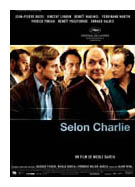 Nicole Garcia’s Selon Charlie: Screened in Filmart, this 2005 pic seemed to me a solid if somewhat academic drama. A network narrative about a fugitive archaeologist in a town full of philandering husbands and bored wives, it’s your basic bourgeois life-crisis tale, decorated with parallels to a mysterious hominid found at a dig site. It has the usual Eurofilm tact and shows how the French have adapted Hollywood’s screenplay structure to fit the well-upholstered stories they like to tell.
Nicole Garcia’s Selon Charlie: Screened in Filmart, this 2005 pic seemed to me a solid if somewhat academic drama. A network narrative about a fugitive archaeologist in a town full of philandering husbands and bored wives, it’s your basic bourgeois life-crisis tale, decorated with parallels to a mysterious hominid found at a dig site. It has the usual Eurofilm tact and shows how the French have adapted Hollywood’s screenplay structure to fit the well-upholstered stories they like to tell.
Benoît Delépine and Gustave Kervern’s Avida: Black and white almost throughout, in 35mm that looks like muddy 16, this surrealist pastiche starts strong. Early scenes offer a new riff on Tati’s Mon Oncle, in which a toff returns to his cyberautomated mansion and encounters problems with dogs and plate glass. Then we’re in Buñuel-Carrière territory (Carrière is in the movie), as a dognapping leads to an amazing scene of pooch decapitation. Things seemed to me to drag as the episodes got sillier and less visually expressive. Rhinos, lions, elephants, big beetles, and a highly diverse sampling of the human species do walk-ons. Not so much metaphysical as pataphysical.
Iran: A Cinematographic Revolution: A documentary on the pre-1990s Iranian cinema. It’s informative, cautious about the role of the mullahs, and filled with intriguing clips from Hollywood-style melodramas and the neorealist-flavored efforts of the 1970s. Good talking heads too (though no Kiarostami). The film reaffirms how single-mindedly the cinema agencies pursued film festivals as a way of increasing the profile of the nation’s culture; the motto was “No festival without an Iranian film.” But can Iran really have trained a total of 90,000 film-related workers, as the docu says?
Johnnie To’s Exiled: I hadn’t yet seen it on the big screen. That’s where it belongs. The first sequence evokes Once Upon a Time in the West‘s opening, and it’s followed by an exhilarating, utterly implausible gun battle. Watch out for that spinning door!
When Mr. To previewed this opening for me last spring, I didn’t think he could top it, but he does. The later scene in the underground clinic will rank with one of the great action sequences of all time. I won’t spoil it for those who haven’t seen it by previewing a still. Let’s just say that To finds fresh compositional tactics in close quarters, as in the hotel climax.
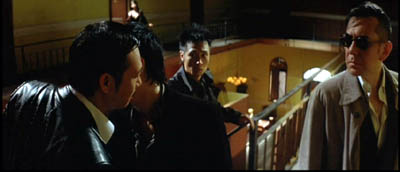
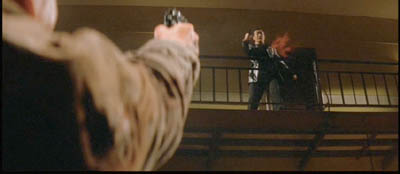
Full of visual invention and neat character bits, Exiled shows that To keeps trying new things. I wrote a little about To’s style in an earlier post, and some backstory on the Exiled rooftop sets can be found here.
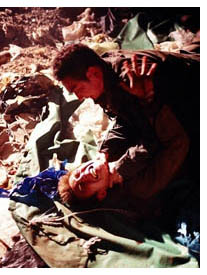 Cheang Pou-soi’s Dog Bite Dog: This tale of a hired killer from Thailand and the raging young cop who pursues him presents a world in Hobbesian frenzy, with all against all. The most unrelentingly violent Hong Kong film I’ve seen in years, Dog Bite Dog starts with imagery of the killer hiding in the bowels of a ship, scraping up flecks of rice from the floor. After consummating his hit, he moves through a landscape of garbage, hiding out in a landfill and rummaging in a recycle bin for scraps to doctor a girl’s wounded foot. I don’t know any film that insists so intently on the textures of urban offal.
Cheang Pou-soi’s Dog Bite Dog: This tale of a hired killer from Thailand and the raging young cop who pursues him presents a world in Hobbesian frenzy, with all against all. The most unrelentingly violent Hong Kong film I’ve seen in years, Dog Bite Dog starts with imagery of the killer hiding in the bowels of a ship, scraping up flecks of rice from the floor. After consummating his hit, he moves through a landscape of garbage, hiding out in a landfill and rummaging in a recycle bin for scraps to doctor a girl’s wounded foot. I don’t know any film that insists so intently on the textures of urban offal.
The cop trembles under the pressure of his own torments, and the parallels between the two men climax in a knife fight in a crumbling Thai temple. As is often the case in local cinema, Father is to blame. This visceral movie surely couldn’t be released theatrically in the US. Even the most jaded action aficionado is likely to flinch from certain scenes.
Cheang’s previous film is the suspenseful Love Battlefield. Of Dog Bite Dog he remarked, “I wanted to show [the audience] this Hong Kong film that does not have choreographed action.” For more, see Grady Hendrix’s coverage here and Twitchfilm’s longish review.
Otar Iosseliani’s Gardens in Autumn: The first shot, in which old men quarrel over which one gets to buy a cheap coffin, puts us firmly in Iosseliani’s parallel universe. As often, he speaks for those who just opt out. A minister of agriculture loses his post and drifts among ne’er-do-well pals, hookers, and girlfriends. A film about drinking, eating, smoking, rollerblading, music-making, and middle-aged sex, Gardens in Autumn also satirizes the rich, who are just as lazy as our heroes but waste their lives shopping. There are also prop gags, including the pictures of heifers and boars that show up in quite unexpected places.
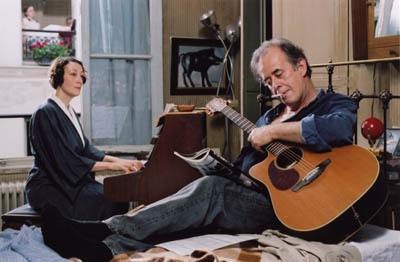
Iosseliani casts himself as an easygoing gardener who draws cartoons on a cafe wall. Some of these images recall people and shots we see in the movie, as if we’re watching the old buzzard create the film between swigs of vodka. An elegiac poem to the subversive force of idleness, with a final scene celebrating women.

Over the next couple of weeks, more frequent posts, I hope, including glimpses of this highly photogenic city. For the moment, this from a double-decker bus must suffice.

The Celestial Multiplex
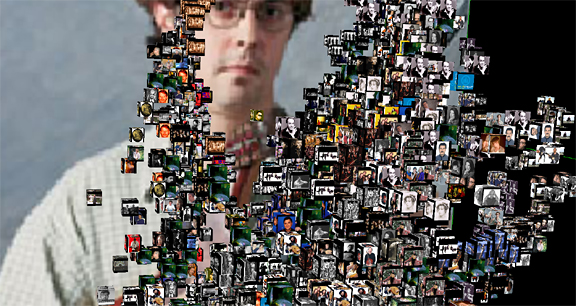
Kristin here—
The Internet is mind-bogglingly huge, and a lot of people seem to think that most of the texts and images and sound-recordings ever created are now available on it—or will be soon. In relation to music downloading, the idea got termed “The Celestial Jukebox,” and a lot of people believe in it. University libraries are noticeably emptier than they were in my graduate-school days, since students assume they can find all the research materials they need by Googling comfortably in their own rooms.
A lot depends what you’re working on. For The Frodo Franchise, studying the ongoing Lord of the Rings phenomenon would have been impossible without the Internet. A big portion of its endnotes are citations to URLs. On the other hand, my previous book, Herr Lubitsch Goes to Hollywood, a monograph on the stylistic and technical aspects of Ernst Lubitsch’s silent features, has not a single Internet reference. Lubitsch can only be investigated in archives and libraries, where one finds the films and the old books and periodicals vital to such a project.
Vast though it is, the Internet is tiny in comparison with the real world. Only a minuscule fraction of all the books, paintings, music, photographs, etc. is online. Belief in a Celestial Jukebox usually works only because people tend to think about the types of texts and images and sounds that they know about and want access to. Yes, more is being put into digital form at a great rate, but more new stuff is being made and old stuff being discovered. There will never come a time when everything is available.
Even so, every now and then someone proclaims that in the not too distant future all the movies ever made will be downloadable for a small fee, a sort of Celestial Multiplex. A. O. Scott declared this in “The Shape of Cinema, Transformed at the Click of a Mouse” (New York Times, March 18): “It is now possible to imagine—to expect—that before too long the entire surviving history of movies will be open for browsing and sampling at the click of a mouse for a few PayPal dollars.”
Not only that, but Scott goes on, “This aspect of the online viewing experience is not, in itself, especially revolutionary.” He’s more interested in the idea that online distribution will allow filmmakers to sell their creations directly to viewers. That would be significant, no doubt, but as a film historian, I’m still gaping at that line about “the entire surviving history of movies.” Such availability would not only be “revolutionary,” it would be downright miraculous. It’s impossible. It just isn’t going to happen.
(The image above was generated to publicize the “Search inside the Music” program that is an important part of the Celestial Jukebox. Imagine movie screens with actors’ faces in those little boxes, and you’ve got the Celestial Multiplex.)
I will give Scott credit for specifying “surviving” films. Other pundits tend to say “all films,” ignoring the sad fact that great swathes of our cinematic heritage, especially in hot, humid climates like that of India, have deteriorated and are irretrievably lost.
Dave Kehr has already briefly pointed out some of the problems with Scott’s claims, mainly the overwhelming financial support that would be needed: “Tony Scott’s optimism struck me as, well, a little optimistic.” On the line about “the entire surviving history of movies,” Kehr suggests, “That’s reckoning without the cost of preparing a film for digital distribution — the same mistake made by the author of the recent vogue book ‘The Long Tail’ — which, depending on how much restoration is necessary, can run up to $50,000 a title. None of the studios is likely to pay that much money to put anything other than the most popular titles in their libraries on line.” As Kehr says, the numbers of films awaiting restoration and scanning isn’t in the hundreds, as Scott casually says. No, it’s in the tens of thousands even if we just count features. It’s more like hundreds of thousands or more likely millions if we count all the surviving shorts, instructional films, ads, porn, everything made in every country of the world. To see how elaborate the preservation of even one short medical teaching film can be, go here.
Putting aside the need for restoration, newer films present a daunting prospect. To help put the situation in perspective, let’s glance over the total number of feature films produced worldwide during some representative years from recent decades (culled from Screen Digest‘s “World Film Production/Distribution” reports, which it publishes each June): 1970, 3,512; 1980, 3710; 1990, 4,645; 2000, 3,782; and 2005, 4,603. For me the numbers conjure up the last shot of Raiders of the Lost Ark, only with just stack upon stack, row upon row of film cans.
Scott isn’t the first commentator to prophesy that all films will eventually be on the Internet. It’s an idea that crops up now and then, and it would be useful to look more closely at why it’s a wild exaggeration. It’s not just the money or the huge volume of film involved, though either of those factors would be prohibitive in itself. There are all sorts of other reasons why the advent of practical digital downloading of films will never come close to providing us with the entire history of cinema.
Coincidentally, two experts on this subject, Michael Pogorzelski, Director of the Film Archive of the Academy of Motion Picture Arts and Sciences, and Schawn Belston, Vice President, Film Preservation and Asset Management for Twentieth Century Fox, visited Madison this past week. Mike got his MA here in the Dept. of Communication Arts and now returns about once a year to show off the latest restored print that he has worked on. Schawn isn’t an alum, but he has also visited often enough that most students probably think he is. The two brought us the superb new print of Leave Her to Heaven that Fox and the Academy have recently collaborated on.
I figured it would be very enlightening to sit down with these two and talk about why the Internet is never going to allow us to watch just anything our hearts desire. They kindly agreed, and with my trusty recorder in tow we went for burgers—and fried cheese curds, a commodity not available in Los Angeles—at the Plaza Tavern. I’m grateful for the fascinating insights they provided into some of the less obvious obstacles to putting films on the Internet en masse.
No Coordinating Body
Before we launch in, though, one point needs to be made: there is no single leader or group or entity out there organizing some giant program to systematically put all surviving movies on the Internet. There isn’t a set of guidelines or principles. There’s no list of all surviving films. How would we even know if the goal of putting them all up had been achieved? When the last archivist to leave turned out the light, locked the door, and went looking for a new line of work?
Most of the physical prints that would be the basis for such transfers are sitting in the libraries of the studios that own them or in the collections of public and private archives (including many individuals). The studios would make films available online for profit. The archives might be non-profit organizations, but they still would need to fund their online projects in some fashion, either by government support, from private grants, or by charging a fee for downloads. Most archives are more concerned about getting the money to conserve or restore aging, unique prints than about making them widely available. Preservation is an urgent matter, and making the resulting copies universally available for public entertainment or education is decidedly a secondary consideration.
Mike works for a non-profit archive, Schawn for a studio, so together they provide a good overview of some key problems facing the creation of an ideal, comprehensive collection of movies for download.
Money
People who claim that all surviving films could simply be put on the Internet don’t go into the technology and expenses of how that could be done.
Of course, Schawn says, studios want to “digitize the library.” That phrase is highly imprecise, however. He specifies, “For the purposes of this idea of media being online, available, downloadable, streamable, whatever, that’s something that we’re dealing with now using existing video masters. So there isn’t an extra cost to quote, unquote digitize. But there is a cost to make the compression master, what we’re calling at Fox a ‘mezzanine file,’ which is basically a 50 megabit file. That’s the highest-quality ‘low’ quality version of the content from which you can derive all of the different flavors of compression for the various websites that have downloadable media.
“There’s a huge problem with this, in that Amazon, iTunes, and Google all have a slightly different technical specification of how they need the files delivered to them. If you don’t have this kind of mezzanine file, you have to make a different compressed version for each one of these, which costs something, certainly. It’s not incredibly expensive, but it’s not free.
“So why? What’s the motivation to us to compress at Fox the entire library? I don’t know. Are we going to sell enough copies of Lucky Nick Cain [a 1951 George Raft film] compressed on iTunes to cover the costs of making the compression? I don’t think so.”
Compatibility and the Onrush of Technology
Schawn’s mention of the variety of files needed by the big download services raises the problem of compatibility. It’s not just a matter of supplying the files and then forgetting about the whole thing, assuming that the film is available to anybody forever. What about new standards and formats?
Shawn: “Just as with consumer video, the standard changes, so what used to be acceptable yesterday isn’t acceptable now in terms of technical quality.” As time passes, plug-ins make access faster and cheaper, and eventually the original files don’t look good enough. He points out that currently iTunes can’t download HD. If it becomes possible later, “If you want to get 24 in HD, what Fox will have to do is go and re-deliver all the files in HD.” And presumably re-deliver again when the next big format revolution occurs.
Mike explains further, “Using the mezzanine file, you would just have to continue to reformat it to whatever the players demand. The lowest of the low quality will keep going up as people have broadband and can handle larger chunks of data faster.”
What about the film you’ve already downloaded? You acquire films using plug-ins, which change. Think how often you’re told that an update is now available. If you go ahead and keep updating, the changes accumulate. Eventually you may not be able to play the download you paid for. Quicktime will have moved way beyond what the technology was when you made your purchase.
Schawn and Mike both point out that at this stage in the history of downloading, the level of quality is still pretty bad in comparison with prints of films in theaters or on DVDs. It would be nice to think that the virtual film archive could provide sounds and images worthy of the movies themselves, but that will take a long, long time–not the “before too long” that Scott envisions.
Copyright
I raised another matter: “But what about copyright? Every time I hear something about restoration or bringing something out on DVD, it’s, ‘Well, there are rights problems.’ And some of those rights problems don’t get resolved. I assume that quite a few films that they blithely believe can be slapped up for downloading can’t be slapped up.”
Schawn: “Sure, and there are often not any kinds of provisions in the contract about Internet distribution—obviously! So you’re right, how do you deal with that?”
He pointed to Viva Zapata as a film that Fox has restored but can’t make available due to rights issues. The potential sales are not thought to warrant paying to resolve those issues. “I’m sure there are lots of titles in everybody’s libraries that you can’t just pop up on the Internet and start selling.”
The copyright barrier is worse for archives, which seldom own the exhibition or distribution rights to the films they protect. Usually—though not invariably–the studios do not object to archives owning and preserving prints. Making money through showing them or selling copies would be quite another matter.
Mike described the online presence of archival prints. “On a much smaller scale, this is being attempted in the archive world already, like on Rick Prelinger’s site [Prelinger Archives] or on the Library of Congress’s site, where they’ve put up dozens of moving-image files. True, it’s not independent cinema and it’s mostly commercials and the paper prints that have recently been restored. On Prelinger’s site it’s all the industrial films that he’s collected over the years. That has seen a good amount of traffic, but it hasn’t created new audiences for these films, I would argue. At least, not on a huge scale.”
Prelinger’s site contains only public-domain items, including the ever-popular Duck and Cover, allowing him to avoid the problem of copyright. Similarly, the Library of Congress gives access primarily to films in the pre-1915 era.
Suppose an archive and a film studio both have good-quality prints of a minor American film made in the 1940s. The archive does not have the legal right to put it online, and if the studio decides that it does not have the financial incentive to do so, that film will not be made available for downloading. A private collector might possibly create a file and make it available, but he or she would risk being threatened by the copyright-holder.
Piracy
We briefly discussed the methods used to prevent pirated copies being made from downloaded films. Like DVDs, downloads can be pirated, with people sending copies to their friends or even offering downloads for a fee in competition with the copyright holder. Copy-protection codes might make it necessary for a purchaser to keep a downloaded copy only on a hard-drive without being able to burn it onto a DVD. Another type of code could erase the file once the film had been viewed once or twice. That’s not exactly conducive to the ideal archive of world cinema, where we would hope to be able to study a film in detail if we so choose.
One might think that piracy protection mainly applies to studios, with their need to make money. Mike points out, though, that the need for such protection “even applies to the archival model, too. For films that you mention that have gone out of copyright, there’s still the same costs associated with putting a silent film that no one owns–digitizing it, creating the compressed master that goes on the Web—and they aren’t the kinds of subjects that people are going to get rich on at all, so there isn’t a lot of piracy. You don’t hear many archivists complaining, ‘Hey, you took my 1911 Lubin film, damn you! You can’t put that on your Website. That belongs on the archive’s Website.’ But that scenario becomes more of a likelihood for more popular titles. The obscure 1911 Lubin film is on one extreme, but Birth of a Nation, a well-known silent film a lot more people would like to see, is on the other. Let’s say the highest-quality copy is on the Museum of Modern Art’s Website and can be easily lifted and posted on your own site. And even if you just say, ‘Oh, I’ll charge 99 cents or I’ll charge 50 cents to stream it,’ it’s still going to be someone taking over something that the archive put all of the high-end effort and money into doing. Frankly, I think unless it’s an archive with a national mandate and a little bit higher budget to digitize and to put the contents of their archives online, there’s not going to be any motivation to make that high-end investment up front.”
Thus an archive may simply not bother to put a film on the internet because it can’t guarantee recouping the costs that would be generated.
Language and Cultural Barriers
Scott’s notion of easy access to all of surviving world cinema implicitly depends on an idea that all these films are either English-language or already subtitled or dubbed for English-speaking users.
That’s not true for a start, so there would remain a great deal of work to translate films that have never been released in English-language markets. That’s another huge, expensive task.
Then there’s the opposite side of that coin. For truly complete access, everyone in the world, whatever language they speak, would be able to download and appreciate every film. Of course, there are billions of people without computers or Internet access, and it looks unlikely that being able to go online will become universal anytime soon. (For figures on numbers of people with internet access, check here; percentages can be calculated by clicking on each country and finding the total population. In Tajikistan, for example, .07% of the population was online in 2005. One has to assume that a lot of connections in some of those countries are dial-up, so downloading films would be virtually impossible. [June 21, 2010: In 2008, Tajikistan’s online population has grown to .08%.])
So let’s just say that for the foreseeable future downloadable films would “only” need to be subtitled in the languages of countries or regions where significant numbers of people subscribe to PayPal.
In our conversation, Schawn pointed out that digital compression files mean that there can be huge numbers of versions, with different soundtracks dubbed in or different subtitles added. Technically it’s possible to do all that translation. Still, “it’s very complicated. So for worldwide distribution of anything, like you’re talking about your silent film. If you’re in Pakistan, do you get the American version of the movie or do you get the version of the movie with the intertitles appropriate to wherever it is that you’re showing it? If so, that quickly compounds the amount of stuff that’s digitized.”
I responded, “Yeah, or a 1930s Japanese film put on the Internet for downloading, subtitled in every language where there are people that can pay for it. The more you think about it, the more absurd it becomes.”
Scott must be implying as well that there is some single “original” version of a film and that that version would be the one available in this ideal collection in cyberspace. Yet any archivist or film historian knows that multiple versions of a given film are typically made, depending partly on the censorship laws of the different countries where it is originally shown. In making downloadable files available, does a studio or archive use only the original version of a film made for its country of origin and thus risk having it include material offensive to viewers in some places where it might be downloaded? Or does a whole slew of different versions, one acceptable in, say, Iran, another inoffensive to the Danes, and still another compatible with Senegalese social mores, get put online? How could one even gather all such versions and digitize them? National film archives tend to have government mandates to concentrate primarily on preserving their own countries’ films. Not every version of every film gets saved.
The Bottom Line
For all the reasons noted here and others as well, film availability for download will follow pretty much the same economic principles that have governed film sales in other media. Mike’s opinion is, “Whether they’re from an archive or a studio, I think things’ll start going online in the same pace that they came onto DVD, in an eight to ten-year cycle. And there still will be large gaps.”
Schawn interjects, “Just as there are on DVD.”
Mike concludes, “There’s stuff that will never go online. Yeah, just as on DVD.”
*
A truly celestial screening: a restored 35mm print of Bertolucci’s 1900 projected free, under the stars in the Piazza Maggiore, Bologna, summer of 2006
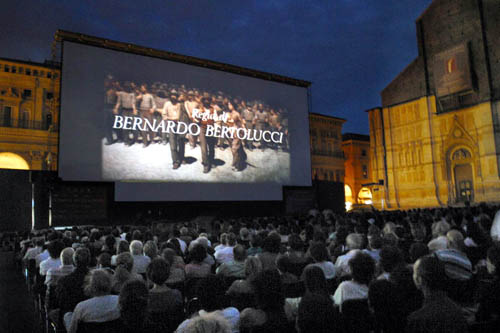
Film forgery
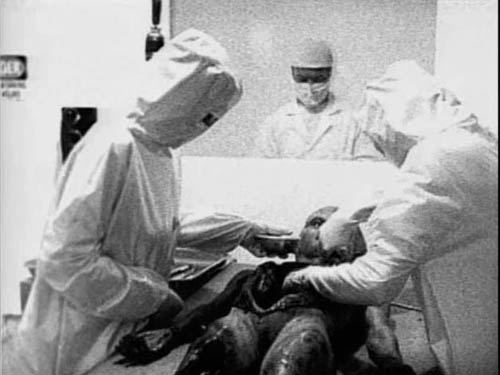
DB here:
In early July 1947, about two weeks before I was born, an alien spacecraft crashed near Roswell, New Mexico. Local ranchers found scattered debris, and soon the US government had cordoned off the area. At the crash site was a flying saucer.
Around it lay several alien creatures. They were small and slender, with large heads, dark slanted eyes, and only four fingers. They were clutching small, flat control boxes. One creature was still alive, and it was taken to an Air Force base in Texas, where it lived for a few more years. The dead bodies were autopsied, and at least one autopsy was filmed.
The US government tried to keep the Roswell incident a secret, but dogged researchers have brought to light eyewitness testimony, official documents, and leaks. There is but one conclusion to draw. We have encountered beings from another planet.
Everything I have just said is almost certainly untrue, except for that part about my being born.
Artistic crimes
Although I’ve been interested in UFOs since I was a kid, what triggered this blog was the recent scandal around pianist Joyce Hatto. Her husband has confessed that her many CD performances of classical pieces were actually digital copies of other pianists’ releases. Critics who praised her virtuosity now have red faces. Denis Dutton, a philosopher of art specializing in what he calls “artistic crimes,” has written a lively essay about the mess.
Summing up what is now a pretty well-established position in aesthetics, Dutton writes that our full understanding of an artwork depends on a general sense of how the work came to be what it is. We may say that all that matters are the words on the page or the paint on the canvas or the sounds in our ear. But our understanding of those sensory features depends upon assumptions about the origins and authenticity of the work.
Here’s Dutton:
The Joyce Hatto episode is a stern reminder of the importance of framing and background in criticism. Music isn’t just about sound; it is about achievement in a larger human sense. If you think an interpretation is by a 74-year-old pianist at the end of her life, it won’t sound quite the same to you as if you think it’s by a 24-year-old piano-competition winner who is just starting out. Beyond all the pretty notes, we want creative engagement and communication from music; we want music to be a bridge to another personality. Otherwise, we might as well feed Chopin scores into a computer.
Dutton has written many subtle and enjoyable pieces on what he calls aesthetic crimes—plagiarism, forgery, and the like. (See his website for many of these, along with continuing updates on his Hatto comments.)
Both plagiarism and forgery present a false history of how a work came into being. You commit plagiarism when you claim as your own something that somebody else created. The Hatto case is plagiarism, just as much as if one college student submits a paper that her roommate has already submitted for another course. A forgery is in a way the reverse: You make the artwork but claim that it was actually created by somebody else, typically somebody famous.
It’s interesting to speculate about what a plagiarized film would be. You can plagiarize somebody’s script by passing it off as your own. Periodically there are lawsuits from aspiring screenwriters claiming that producers ripped off spec scripts. But can you plagiarize a movie itself?
I suppose you can try, but it would be very hard to pull off. I might swipe a finished film’s negative from the lab and then make new credit sequences that replace the director’s name with mine. But I could hardly expect to get away with it, since nearly everybody involved would notice. Perhaps I could find an old forgotten film and then stick my name in there somewhere. Again, though, I’d have to explain how I could have been around to make that 1930s Monogram musical or 1960s Taiwanese kung-fu film. As Dutton points out, I’d have to tell a plausible story about how the work came to be.
What if I just swipe bits? Recall that a plagiarism can be partial or total. Even if you pluck just a paragraph or two from your roommate’s term paper and write the rest of yours unaided, that still counts as plagiarism. But if your roommate makes a film, and you lift a sequence from it for your own, the case for plagiarism seems to me less clear—especially if she gives you the same sort of permission she might grant for a paper.
Does Bruce Conner’s use of stock footage in A Movie constitute plagiarism? We assume that he didn’t shoot all this material, yet he doesn’t give credit to any of his sources. Indeed, as he once wrote to Kristin and me, “Only the splices are mine.”
We’d now be inclined to say that Conner appropriated the shots, something a great deal of contemporary art does. Rappers, samplers, and electronic artists like Moby are clearly seizing work without acknowledgment. Perhaps entertainment companies are in effect complaining that YouTube downloads and Web mashups are plagiarism. Yet there’s no intent to deceive the viewer about the source, so plagiarism doesn’t seem the right concept for these instances.
What about cases in which one director replaces another on a film project and assimilates material that the first one shot? Did Richard Lester plagiarize Richard Donner’s footage for Superman II? It sounds weird to say that; Lester just used parts of what Donner left.
Literary plagiarism can involve stealing not only exact wording but also original ideas. This is a fuzzy area, obviously, since ideas can’t be copyrighted. But it’s even fuzzier in filmmaking, where such swiping is pretty common. All those copies and unauthorized remakes of Hollywood films, like Hong Kong Pretty Woman and Kaante, the Bollywood version of Reservoir Dogs, might count as plagiarism. (The producer of Kaante calls it an homage.) Still, my inclination is to say that plagiarism is a difficult concept to transfer to the visual/moving image arts; its core application may be literary and, as the Hatto case reveals, musical performance.
Anyhow, today I’m interested in the other major aesthetic crime, forgery. The question is: Can you forge a film?
Forgery and pastiche
Nowadays, especially after Forrest Gump, we’re accustomed to seeing simulated documentary footage in fictional films. The earliest example I can recall is Citizen Kane, in which the newsreel fakes old footage showing Kane campaigning with Teddy Roosevelt or standing beside Hitler.
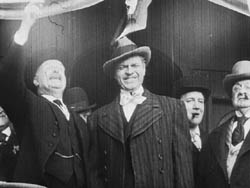

Such shots don’t claim to be factual. No matter how realistic the shot looks, the presence of the protagonist tells us that it’s functioning within a fictional tale. There is, in other words, no question of deceit. It’s a case of artistic license, somewhat like dressing contemporary actors in period costume. Had Welles claimed that he had discovered old newsreel clips containing a mysterious man who resembled him, that would be a different story.
I’d suggest that such frank efforts to mimic the look and feel of older footage fall into the category of pastiche. Pastiche is the acknowledged copying of techniques of recognized art styles. In Stravinsky’s neoclassical period, he composed Pulcinella, an overt pastiche of Pergolesi.
It’s a separate but interesting question about how accurate a filmic pastiche is. The Good German, I suggested in previous posts, tries to be a pastiche, but it isn’t very skilful. Indeed, most aren’t. Bergman’s TV film The Last Scream (1995) includes a pastiche of the great 1910s filmmaker Georg af Klercker, but it’s not faithful to af Klercker’s style. (The mock silent film in Prison and Persona is somewhat better.) Welles’ pastiche of old footage in Kane‘s “News on the March” segment is more carefully done, especially for its time. The movement is convincingly jerky for silent film shown at sound speed, and Welles cleverly scratched and mis-exposed some of the staged footage, anticipating a technique often used today.
The most convincing film pastiche I know since Kane comes in the Japanese film To Sleep so as to Dream (Yume miruyoni nemuritai, 1986). The plot involves two detectives trying to find a lost silent film, and at intervals we see clips of it, a swordplay movie (chambara). The shooting style is very close to the flashy technique we see in films from the era; obviously the director Hayashi Kaizo studied surviving chambara carefully. In one scene, a swordfighter pauses in a doorway, and we see him over the shoulder of his adversary (first image below). As the fighter makes a hurling movement, we cut in a bit closer. Suddenly the foreground figure’s arm jerks up, revealing a dagger jabbed into his wrist (second image below).
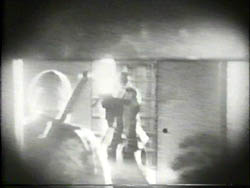
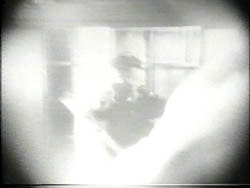
Hayashi has also faded and flared the imagery, as if our print had degraded through duping and ill use.
Pastiches aren’t forgeries because there’s no intent to deceive. Just as important, the history of their production tells us that they aren’t genuine. As Dutton points out, it’s not enough for a forgery to look like an old artwork; to succeed, it needs a provenance, a false history of creation and subsequent ownership. I can think of two well-known films that can be considered forgeries to some degree.
With typical Scottish pragmatism
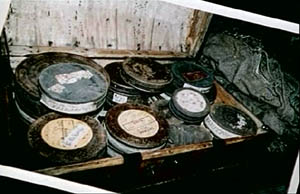
Peter Jackson and Costa Botes’ Forgotten Silver (1995) tells the story of the neglected New Zealand filmmaker Colin McKenzie. McKenzie started making films around the turn of the century, and in the course of his career he built his own camera, manufactured his own film stock, invented talking pictures and color cinematography, shot the first close-up, and erected a gigantic set in the New Zealand bush. Many experts, including Leonard Maltin and various archivists, attest to McKenzie as a visionary filmmaker on a par with D. W. Griffith.
Of course he never existed. But in the straight-faced manner of This is Spinal Tap, Forgotten Silver pretends that he did. The result is a brilliant parody of the filmmaker documentary as practiced above all by Kevin Brownlow. We get the talking-heads experts, the search for lost footage and locations, the pan-and-zoom coverage of old stills, and the terse journalistic voice-over. (“With typical Scottish pragmatism he built his farm the hard way.”) The film makes fun of nationalistic film history (we did it before the others) and the biographical convention that treats the artist as a rebellious, suffering soul.
The silliness of the enterprise is pretty apparent. The resourceful McKenzie is a one-man film industry. He devises a projector driven by steam power, he manufactures film emulsion from eggs, he builds his Salome city single-handed, and a Russian woman named Alexandra Nevsky tells us about Stalin’s interest in our hero. To anybody who knows Harvey Weinstein’s tendency to slice up the films he distributes, his remark about taking an hour out of McKenzie’s masterwork gives the whole game away.
There are clips as well. The passages from McKenzie’s Griffithian feature Salome are fair approximations of 1920s international style, a bit à la Guy Maddin, while the oldest shots look remarkably accurate.
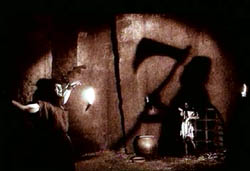
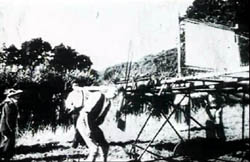
But Jackson and Botes decided to go Spinal Tap one better. Before Forgotten Silver aired on Kiwi television, they let a journalist publish a story suggesting that McKenzie really existed. The mockumentary was taken for truth, and McKenzie immediately became a new national hero. Startled, the filmmakers quickly confessed their chicanery. Some people enjoyed the laugh, but others felt cheated and muttered about artists who fool around at the taxpayers’ expense. The fullest account I know is in Brian Sibley’s biography Peter Jackson: A Film-Maker’s Journey (Hammersmith: HarperCollins, 2006), 280-302. On the web, have a look here.
Because of the Jackson/Botes hoax concerning the “rediscovered” footage, the faked McKenzie scenes became forgeries, at least for a little while. When the mischief was discovered, the clips stood revealed as parodies or pastiches of silent film. If we have reason to believe that the footage is authentic, we think of McKenzie as a pioneer filmmaker. If we’re told it’s all faked, we congratulate our adept contemporaries.
In the spirit of Forgotten Silver are other nonexistent but rediscovered filmmakers. Most recently we have J. X. Williams, conjured up by Craig Baldwin and Noel Lawrence. Williams’ Peep Show was presented as an authentic 1965 movie, although many had their doubts when they saw footage lifted from The Man with the Golden Arm and other pictures. Lawrence insists that Williams existed and has set up a website dedicated to him, but one has to believe that it’s less an effort to deceive than a PoMo performance exercise.
The Gray’s anatomy
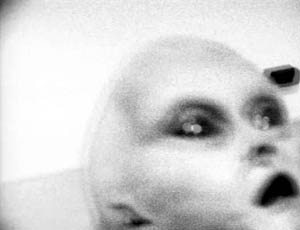
The grandest film forgery I know is Alien Autopsy. This has been a favorite of mine since I saw the Fox TV program, Alien Autopsy: Fact or Fiction?, broadcast in the summer of 1995. Kristin and I were especially pleased to see our old friend Paolo Cherchi Usai, then of Eastman House, as a talking head in it. I got the movie on laserdisc, hoping to use it in a film theory class. I never did, but now I get a chance to blog about it! The show is available on DVD, including the full “original” footage. A useful Wikipedia overview is here.
The film shows an autopsy performed on one of the saucer creatures, known in UFO parlance as a Gray. The grainy black-and-white footage presented to the public runs about 16 minutes, but it’s supposedly drawn from much more material. There seem to me three central issues in establishing its authenticity: what we are shown, how we are shown it, and when it was made.
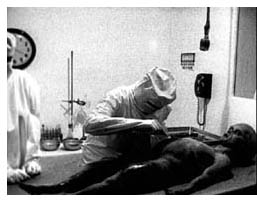 What we see is a sterile white room with a stiff Gray stretched out on a lab table. Two figures in decontamination suits move around the table, cut into the body, and remove various organs. A third, rather creepy figure can occasionally be glimpsed in a window watching. The furnishings are pretty sparse, but you can see a clock, a wall phone, a microphone, and an instrument tray.
What we see is a sterile white room with a stiff Gray stretched out on a lab table. Two figures in decontamination suits move around the table, cut into the body, and remove various organs. A third, rather creepy figure can occasionally be glimpsed in a window watching. The furnishings are pretty sparse, but you can see a clock, a wall phone, a microphone, and an instrument tray.
As you can imagine, what we see has been intently scrutinized. Is the Gray an organic body or a dummy? Do the surgeons follow proper autopsy procedures? Are the clothes and furnishings faithful to the period around 1947? Special-effects experts have talked about how difficult it would be to design a fake creature, physicians have assessed the surgical techniques, and researchers have tried to establish when wall phones with coiled cords came into use. The Fox special includes some of these debates.
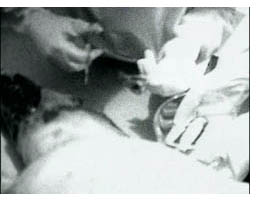 How we’re shown the autopsy has also become a matter of controversy. The film was shot with a handheld 16mm camera, and the cinematographer constantly shifts position. The camera stays quite close, circling the surgeons and moving toward and away from the corpse. As the camera draws closer to the body, the shot often goes out of focus.
How we’re shown the autopsy has also become a matter of controversy. The film was shot with a handheld 16mm camera, and the cinematographer constantly shifts position. The camera stays quite close, circling the surgeons and moving toward and away from the corpse. As the camera draws closer to the body, the shot often goes out of focus.
Some experts on combat cinematography have claimed that this is a plausible way to cover the action. The camera weaves around because the operator is trying to stay out of the way of the doctors, and the fixed-focus lenses can’t sustain focus in the natural light of the room. Other experts have said that the authorities would have handled this momentous event in a far more careful way, employing several fixed cameras, color film, and brilliant lighting. Skeptics point out that the monochrome imagery, bobbing camerawork, and loss of focus on details all conveniently make the event harder to see.
So it’s rather hard to determine the autopsy’s authenticity just by looking at the footage. We need external information about its provenance.
Funny thing . . . that’s just what’s lacking.
When was the film made? Well, does it employ 1947 film stock? Answer: Not clear. Eastman Kodak representatives have verified that the pieces of film they were shown could have come from 1947, or from 1927, or 1967. But were the pieces of film that the experts examined taken from the footage showing the dead Gray? Not clear. Moreover, the owner of the footage steadfastly refused to submit the film to a chemical analysis that would determine its age. Big problem here.
Further, what was the chain of custody for the footage? Again, not clear.
Roswell Incident eyewitnesses tend to hang onto physical evidence for decades. One man who nabbed a debris fragment kept it on top of his TV set. But when inquiring minds ask to have a look, the artifacts suddenly go missing.
That makes it remarkable that a former military photographer identified as Jack B. came forward claiming to hold several hundred reels of autopsy footage. In the early 1990s Jack offered to sell the material to TV producer Ray Santilli. But Jack didn’t want his real name divulged. That yields another problem with establishing provenance.
Things get wilder. Michael Hesemann and Philip Mantle, in Beyond Roswell (1997), argue that the creature on the table isn’t a Roswell victim at all but a corpse recovered from one of many other crashes that took place at the time. Hesemann and Mantle have also deciphered the markings on the debris shown in Santilli’s film. The text turns out to be similar to ancient Hebrew, classical Greek, and other ancient languages. Did the Grays teach our ancestors their culture? To read this literature is truly to plunge down the rabbit hole. (That’s why I like it.)
So the when question seems to be as murky as the others.
Skeptics have torn into this movie along all three dimensions. The most convincing demolitions of it seem to me the very early piece by Joe Nickell, in the Skeptical Inquirer of November/ December 1995 and Joe Longo’s 1997 dissection on the Society of Operating Cameramen’s website. Longo, president of the International Combat Camera Association, offers a detailed critique of the case. For what it’s worth, many who believe in UFOs also immediately took the film to be bogus.
So is Alien Autopsy a forgery? Yes. Last spring Santilli admitted faking the film, but he offered a new explanation. He maintains that there was a genuine autopsy film, but after he bought it, he found that 95% of it had “oxidized,” whatever that means. So he staged and shot a film that would replicate what the mysterious Jack B. had originally shown him. Santilli explained: “It’s no different from someone restoring a work of art like the Mona Lisa or the Sistine Chapel.”
A special-effects specialist has acknowledged making the dummy Gray. Santilli also faked the inscribed debris shown in the film. At this point Philip Mantle, who had written yet another book claiming that the film might be genuine, denounced the entire affair as a hoax.
In sum, we have the intent to deceive coupled with the wrong provenance. As Dutton would point out, we see the film differently when we know what sort of achievement it is: a middling piece of fakery.
In a remarkable piece of timing, a British feature film was released just as Rick Santilli admitted his duplicity. It was called Alien Autopsy, and it shows two lads setting out to film a faked Gray autopsy. Santilli was credited as a producer. I leave it to you to decide if that movie is an adaptation, a forgery, a plagiarism, a pastiche, or just the extension of a brand.
Thanks to Paisley Livingston, Mette Hjort, and Bérénice Reynaud for discussing many of these matters with me. Paisley in particular gave me helpful pointers and showed me the af Klercker pastiche by Bergman. Thanks also to George Thomas for a factual correction.
P.S. 27 March 2007: Nate Dorward writes to remind me of First on the Moon, a 2005 mockumentary that was taken by the press as a faithful record of Russia’s space program. I haven’t seen it, but it sounds like a Forgotten Silver case: a pastiche or parody that became, inadvertently, a forgery.
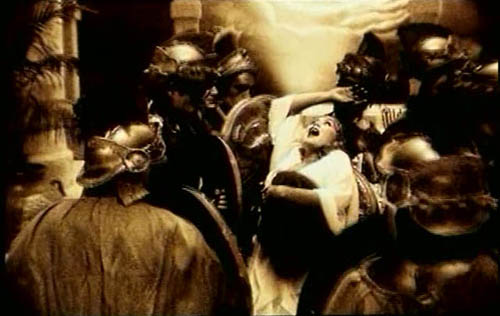
Salome crushed by the guards’ shields in Colin McKenzie’s 1920s epic Salome.
A many-splendored thing 4: Triangulating
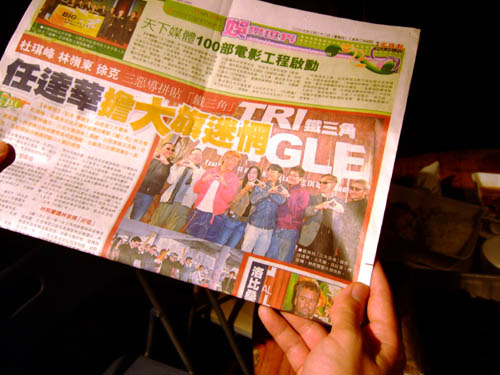
DB, still in Hong Kong:
Three directors of renown collaborate on a single film. Each is responsible for one part. But unlike your ‘portmanteau film,’ which tells separate stories (e.g., RoGoPaG or Paris je t’aime), in this project the same plot and characters are followed throughout. To make things interesting, the director of part one doesn’t tell the others what he’s planning; he simply presents a finished third. The second director has to take that further, and the man at the end has to wrap things up.
Hong Kong director Johnnie To came up with the idea for Triangle, and it’s nearing completion. Tsui Hark has finished the first section, Ringo Lam the second. Now To is shooting the conclusion, and he kindly invited Shelly Kraicer (Chinese movie expert), Todd Brown (of Twitchfilm.net), Antoine Thirion (of Cahiers du cinéma), and your obedient servant to a late-night shoot on Thursday. Milkyway mainstay Shan Ding was our guide.
I don’t have to tell you it was fun.
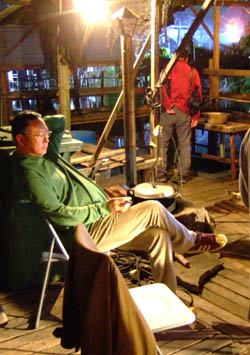
The setting is a rundown cafe perched on a swampy pond in the New Territories. The location is near the forest where the armored-car shootout takes place in Exiled. We saw To shoot a scene with Lam Suet, Louis Koo, and other actors meeting in the café. In this portion, Lam is sprawled on the floor.
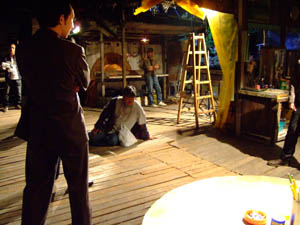
The scene climaxes with one actor dangling from a hole in the roof. You can see Mr. To in the lower right foreground watching the shot on his video assist, a monitor that shows what the camera sees. Maybe you can glimpse the shadowy assistant on the rooftop helping the actor hold on.
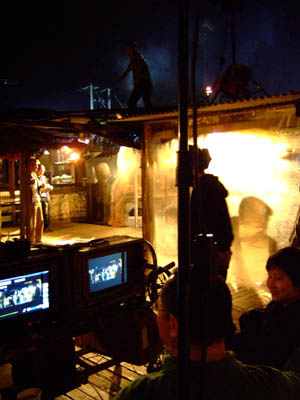
Meanwhile, the camera is shooting off on the right. It was a good opportunity to watch how To uses camera movement (constant in his films). Here you can see the camera dolly and the rail tracks it coasts along.
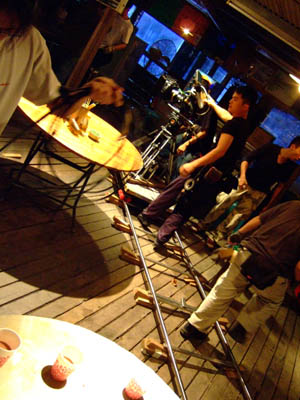
Louis Koo was also there, but not too visible. Simon Yam showed up for another scene, this one in the forest. Simon exudes charm and is warm and unpretentious. I first met him in 1995 at the Hong Kong Film Awards banquet, and he looks as handsome and mischievous as ever.
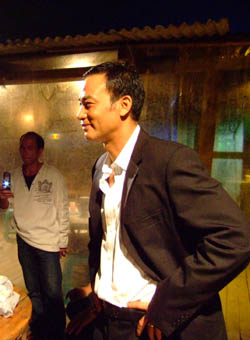
Kelly Lin arrived soon afterward. Another charmer, she told me she grew up in Santa Barbara and went to UC-Irvine. She’s been in a lot of recent HK movies.
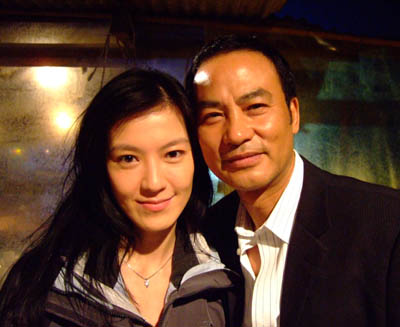
Later, shooting in the forest, the Milkyway team worked efficiently. We guests were parked on a little pier to watch from a distance.
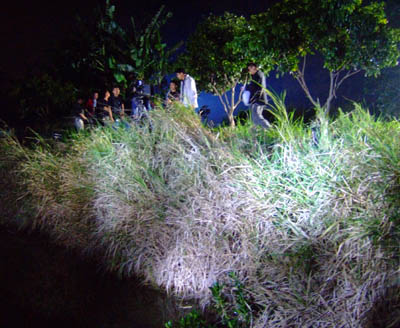
A crew member rustled a big sheet of plastic to create the impression of reflections from the water.
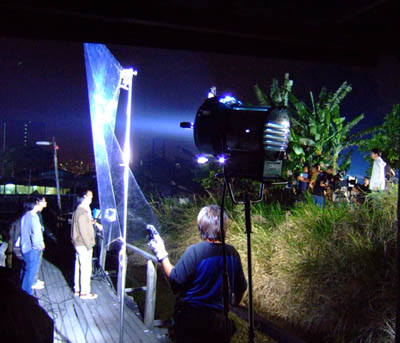
I’ve visited other Milkyway shoots, and each time I’ve been impressed by the sheer speed with which the work gets done. Everybody knows his/her job, and the staff changes camera and lighting setups very quickly. It also helps that HK films are almost always shot with no sound recording; everything is postdubbed. That yields the visual freedom, as well as the speed of production, of silent-era moviemaking.
In another echo of old production methods, To’s films sometimes use rooftop sets. Last year the set for the hotel in Exiled was erected on the top of the Milkyway building. Its Demy-like pastels looked very artificial in daylight.

But check out the results on film, shot at night.
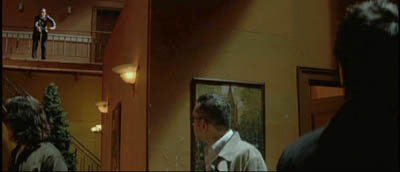
To’s art is furthered by his craftsmanship in shot composition. Composing in anamorphic (2.35:1), nearly always putting the camera on a tripod or dolly, he gets precise results with few lighting units. When I complained that all the new films I saw at Filmart were shot shakycam, Shan Ding reported a neat saying that HK DPs have. The handheld camera covers 3 mistakes: Bad acting, bad set design, and bad directing.
Unlike Hollywood filmmakers, who fiddle with the film by pushing and pulling and bleach bypassing and digital fixing in postproduction, Mr To just lets the film do its rich photochemical work. Expose it correctly, anchor the camera, and 35mm film stock can look gorgeous. His films show that we already have a high-definition moving-image medium, using not pixels but molecules. Motto: Let the emulsion be your friend.
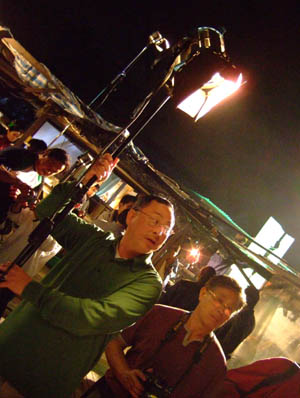
Shan also told me that the anamorphic format used by Milkyway is Technovision, an Italian system from the 1970s. These lenses yield lovely images with good depth of field, and To likes to fill up the wide frame with complicated blocking. Here’s an example from Exiled.
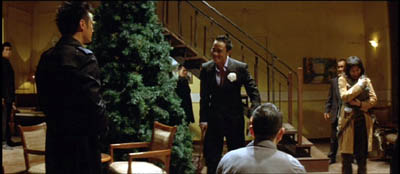
According to Rick Mitchell, Vittorio Storaro used Technovision lenses on Apocalypse Now and other pictures. It’s another way in which To is maintaining a heritage of quality—while also being economical. Milkyway owns the lenses, so no need to rent from local supply houses.
Mr To, Shan Ding, and the rest of the crew were very kind to us, even providing snacks and suggesting a group picture. Who could resist an offer like that?
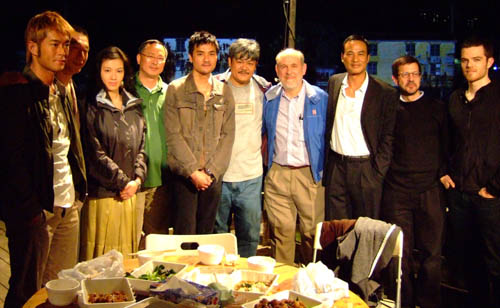
Later in my stay, I hope to report on another upcoming Milkyway film, the Simon/ Kelly pickpocket movie called The Sparrow.
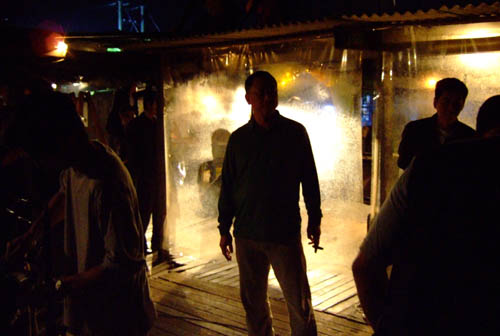
PS 24 March: I was told that Johnnie To came up with the idea for Triangle, but Vicki Rothrock reports for Variety that it was Tsui’s concept originally. Thanks to D. W. Hudson of GreenCine Daily for the link.
PPS 27 March: For Todd’s coverage of our set visit , go to Twitchfilm here.
PPPS 14 May: Per Variety, Triangle is a late addition to Cannes.
PPPPS 4 December 2010: Correction: The original entry claimed, inaccurately, that Mr. To used Techniscope, a two-perforation non-anamorphic format. The process being used is in fact Technovision, an anamorphic format. My apologies for the error.













